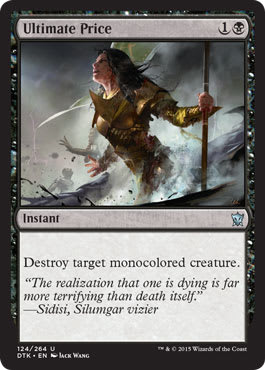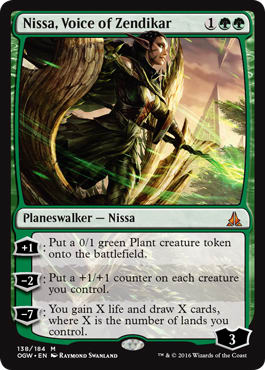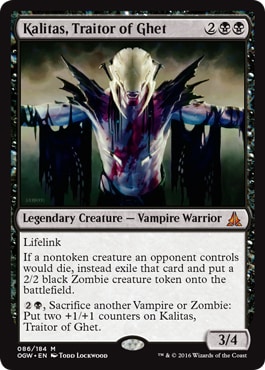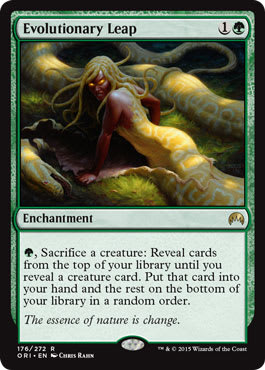I tried. I really did.
I tried so hard to play a deck without Nantuko Husk this Standard format. There were a total of zero black creature decks on my list of “Decks I’ll Learn to Pilot” in order to deter myself from playing the Zombie Insect.
Then, something [Matt] Nassty happened. Luis Scott-Vargas had a feature match at Pro Tour Shadows over Innistrad with this beauty:
B/G Rite ? Shadows over Innistrad Standard | Luis Scott-Vargas, Top 8, Pro Tour Shadows over Innistrad
- Creatures (30)
- 4 Blisterpod
- 4 Catacomb Sifter
- 4 Duskwatch Recruiter
- 4 Elvish Visionary
- 4 Loam Dryad
- 4 Nantuko Husk
- 4 Zulaport Cutthroat
- 2 Liliana, Heretical Healer
- Spells (7)
- 4 Collected Company
- 3 Cryptolith Rite
- Lands (23)
- 4 Swamp
- 8 Forest
- 3 Westvale Abbey
- 4 Hissing Quagmire
- 4 Llanowar Wastes
- Sideboard (15)
- 4 Ultimate Price
- 4 Transgress the Mind
- 2 Tireless Tracker
- 2 Ulvenwald Mysteries
- 2 Kalitas, Traitor of Ghet
- 1 Fleshbag Marauder
Clearly, there is a lot going on here, but it isn’t anything too new.
This is a deck based on synergies that come from sacrificing creatures and generating a slew of triggers when creatures die. This isn’t quite a Rally the Ancestors deck, as it lacks the I-win-styled panic button the Rally deck had. Instead, this deck has significantly more explosive draws with the closest thing we’ve had to Earthcraft since the Legacy-banned enchantment itself.
One enormous parallel between this deck and last format’s graveyard deck is the flow of the deck. Both decks tended to play a low-to-the-ground, mediocre aggressive strategy that would chip away at the opponent’s life total before using an over-the-top means of dealing a significant amount of damage in a single turn. It is pretty easy to surprise-kill an opponent with Westvale Abbey and Zulaport Cutthroat being used in conjunction with one another. A sudden “drain” (opponent loses life and controller gains that much life) for 14 life is no joke.
After a few hours of theory-crafting with friend and roommate Jake Humphries, an initial rough draft from Saffron Olive, and a liter of Cheerwine later, I arrived at this list:
B/G Rite ? Shadows over Innistrad Standard | Emma Handy
- Creatures (30)
- 4 Blisterpod
- 4 Catacomb Sifter
- 4 Duskwatch Recruiter
- 4 Elvish Visionary
- 4 Loam Dryad
- 4 Nantuko Husk
- 4 Zulaport Cutthroat
- 2 Liliana, Heretical Healer
- Spells (8)
- 4 Collected Company
- 4 Cryptolith Rite
- Lands (22)
- 4 Swamp
- 6 Forest
- 4 Hissing Quagmire
- 4 Llanowar Wastes
- 4 Westvale Abbey
- Sideboard (15)
- 3 Ultimate Price
- 3 Nissa, Voice of Zendikar
- 3 Duress
- 2 Kalitas, Traitor of Ghet
- 2 Caustic Caterpillar
- 2 Evolutionary Leap
The sideboard felt very smooth in the rounds I played with the deck, and I wouldn’t change very much going forward. The biggest difference between my main deck and Team Channel Fireball’s is that mine appears a bit more streamlined toward the Abbey/Rite plan, while theirs plays to a bit more toward inevitability through Duskwatch Recruiter.
To expand a bit on my sideboard plans, let’s have a look at each individual card in the sideboard.
Ultimate Price — This was primarily to answer Kalitas, Traitor of Ghet, Archangel Avacyn, and Archangel of Tithes. There are other splash applications that the card has, but in this particular archetype, you want to dilute the deck’s synergies as little as possible while sideboarding. This means anything in the sideboard has to serve an important role or be high-impact to warrant inclusion in the sideboard.
Nissa, Voice of Zendikar — Nissa is a fantastic card in mirrors that result in large board stalls between creature decks with a million creatures on the battlefield. While the package of Cryptolith Rite and Westvale Abbey is able to generate reasonable advantages in these mirrors, they are relatively contingent on having large amounts of mana via the namesake enchantment. This wasn’t a requirement I was comfortable with, as many of the Collected Company/Token decks are playing significant numbers of Dromoka's Command.
The value of Nissa, Voice of Zendikar’s +1 ability cannot be understated in a deck that revolves around assembling a critical mass of creatures. When Nantuko Husk, Zulaport Cutthroat, Catacomb Sifter, and Westvale Abbey only care about having warm bodies (or lukewarm, leafy ones), the first ability on the 3-mana ’Walker feels like drawing a free card and casting it for 0 mana.
Duress — Most of the non-Kalitas cards this deck cares about are noncreature spells. I previously valued being mana-efficient over versatility (this goes back to my list being as streamlined as possible, compared to the CFB crew trying to cover more bases), and while that may be incorrect going forward, the speed and efficiency that comes with Duress is hard to ignore.
Many draws in the deck are a 1-drop into Cryptolith Rite, which allows the pilot to snag Kozilek's Return or Flaying Tendrils on the draw. This isn’t as much of a concern when there’s only one creature on the battlefield, but if the draw is Loam Dryad into Zulaport Cutthroat or Elvish Visionary, it is a bit more important to take the sweeper early in order to try to establish a board presence early.
If B/G Rite ends up being a staying archetype, Transgress the Mind may end up being a necessary evil to combat an influx of Kalitas, Traitor of Ghet. For now, I am comfortable just answering Chandra, Flamecaller, Kozilek's Return, Flaying Tendrils, Languish, Radiant Flames, Fall of the Titans, Dark Tutelage, Virulent Plague, Dromoka's Command, Descend Upon the Sinful, Pyromancer's Goggles, and Tragic Arrogance.
Kalitas, Traitor of Ghet — Kalitas was included in the deck in anticipation of a number of mirror matches that would occur now that the cat was out of the bag. I played a single mirror in a Preliminary Pro Tour Qualifier on Saturday, I had Kalitas on turn three on the draw, and the game more or less ended on the spot. It really cannot be understated how important Kalitas is in the mirror match.
One of this deck’s plans (when Zulaport Cutthroat and/or Westvale Abbey are nowhere to be found) is good-ol’-fashioned Nantuko Husk beatdown. Kalitas plays very well into this plan in matchups that involve a significant amount of creature combat.
One pseudo-drawback of Nantuko Husk in creature mirrors is highlighted when the Husk’s controller has to continually sacrifice creatures in order to keep the Husk alive in combat. This isn’t always sustainable against decks like Collected Company or Tokens, as they can go toe-to-toe in sheer number of creatures on the table, and the end result is Nantuko Husk’s controller trading creatures in matchups in which it can’t quite afford to. Kalitas, Traitor of Ghet is a particularly welcome supplement in these board stalls, as he is able to help the Cryptolith Rite player keep creatures on the battlefield. Every time that Husk player sacrifices a creature, it is (in theory) to eat another creature. This results in a Zombie being made with Kalitas—a perfect snack for the Traitor or the undead bug.
When Nantuko Husk beatdown is in the plan, it is also quite important to make sure that, when a Deathmist Raptor is forced off the table, it stays off the table.
Caustic Caterpillar — This is easily the most suspect inclusion in the sideboard (and is the most likely card to get the axe going forward), but keep an open mind.
One way the Rally the Ancestors deck would protect its creatures of Silkwrap and Stasis Snare effects was just to sacrifice them to Nantuko Husk or Sidisi's Faithful (off a Collected Company) in response to the creature being targeted by the enchantment’s trigger. With the low number of Liliana, Heretical Healers in the deck, this isn’t always a viable option. A vast majority of the time a creature hits the graveyard in this deck, it’s gone.
Caustic Caterpillar was meant to be an answer to the various Oblivion Ring-style effects that are seeing play, with splash applications against Always Watching, Pyromancer's Goggles, and Hedron Archive. The Caterpillar got the nod over Naturalize because it can be hit by Collected Company and plays better with Nantuko Husk, Liliana, Heretical Healer, Westvale Abbey, and Cryptolith Rite in case the opponent doesn’t have something worth destroying.
It’s hard to say if Caustic Caterpillar is worth including in the future, as it is relatively narrow, but it worked reasonably for me (particularly against the Brad Nelson–style Pyromancer's Goggles Ramp).
Evolutionary Leap — In playtesting toward the beginning of the format, many of #TeamBolas’s decks that had piles of creatures in them would play Evolutionary Leap in them to great effect. It seemed to be a natural fit in the sideboard against removal-heavy decks as a card that would help generate card advantage while pulling double-duty as a sacrifice outlet.
I only brought Evolutionary Leap in twice during the duration of the tournament, but drawing it early against W/B control allowed the deck to pretty convincingly beat two copies of Languish, a Descend Upon the Sinful, a Sorin, Grim Nemesis, two copies of Secure the Wastes, a Gideon, Ally of Zendikar, and a Flaying Tendrils—all without drawing a single copy of Collected Company or transforming Westvale Abbey.
Sideboarding with this deck can be summed up with a simple adage: “Less is more.” This deck is a pile of mediocre Draft picks that have inherently powerful synergies between them. The more seemingly powerful cards the pilot brings in, the more it dilutes the synergies themselves. This leads to the deck suffering as a whole. The power of each draw step is directly proportional with how well the card drawn plays to the current board. If there isn’t a sacrifice outlet or pile of creatures on the battlefield, Zulaport Cutthroat is a pretty underwhelming draw (despite being one of the most important cards in the deck).
Mono-White and W/u Humans
Out: 2 Cryptolith Rite, 1 Nantuko Husk
In: 3 Ultimate Price
Generally speaking, I have found myself to be assuming the role of the control player in this particular matchup, and I want to reduce the risk of losing a draw step to duplicate copies of Cryptolith Rite. The shaving of Nantuko Husk is a concession to the fact that it will rarely push through the wall of little people and is one of the more mana-hungry spells.
There’s a strong case for shaving Liliana, Heretical Healer on the draw (instead of Husk) here, but the constant production of chump-blockers has proven invaluable. Something as simple as recurring Blisterpods is a game-changer against the deck full of Dragon Hunters and Kytheon, Hero of Akros.
Bant Company
Out: 4 Cryptolith Rite, 1 Nantuko Husk
In: 3 Ultimate Price, 2 Nissa, Voice of Zendikar
Ultimate Price is the ever-crucial answer to Archangel Avacyn. An Avacyn transforming is probably game over for the B/G deck if the two decks are anything close parity with one another. Nissa, Voice of Zendikar helps the B/G deck keep up with the creatures that Bant Company can produce. It isn’t an easy matchup, and Tragic Arrogance is scary, but it is very favorable overall. The deck doesn’t interact with B/G in meaningful enough ways to stop the deck, and it makes it a nightmare for the Bant deck. It’s very reminiscent of the matchup of Bant Company vs. Rally the Ancestors from the previous Standard format.
In case the opponent has Deathmist Raptor, it is recommended to shave another Nantuko Husk and lower the number of copies of Ultimate Prices being brought in to two in order to fit Kalitas, Traitor of Ghet in the deck. Kalitas (somewhat) turns off Avacyn transforming in a proactive way, assuming the opponent doesn’t have a way to make a non-Angel creature token die.
R/G Ramp
Out: 1 Cryptolith Rite, 2 Catacomb Sifter
In: 3 Duress
The sideboarding out on this one is more to taste than anything. I am not a fan of Catacomb Sifter in the matchup (especially on the draw), as a pair of ramp spells out of the opponent means that player will have Chandra, Flamecaller mana the turn after a Catacomb Sifter hits the table. When up against the Pyromancer's Goggles version of Ramp, axe the Lilianas from the main deck for the Caterpillars in the sideboard. The Goggles version relies on artifacts as a form of ramp, and Caterpillar’s ability to pseudo-Strip Mine them is fantastic.
Goggles Ramp ? Shadows over Innistrad Standard | Brad Nelson, Pro Tour Shadows over Innistrad, Top 8
- Creatures (4)
- 3 World Breaker
- 1 Dragonlord Atarka
- Planeswalkers (2)
- 2 Chandra, Flamecaller
- Spells (30)
- 3 Fall of the Titans
- 4 Fiery Impulse
- 4 Kozilek's Return
- 3 Magmatic Insight
- 3 Traverse the Ulvenwald
- 4 Nissa's Pilgrimage
- 4 Tormenting Voice
- 2 Hedron Archive
- 3 Pyromancer's Goggles
- Lands (24)
- 5 Mountain
- 8 Forest
- 3 Cinder Glade
- 4 Drownyard Temple
- 4 Game Trail
- Sideboard (15)
- 1 Chandra, Flamecaller
- 3 Den Protector
- 3 Tireless Tracker
- 3 Rending Volley
- 1 Dragonlord Atarka
- 2 Goblin Dark-Dwellers
- 2 Draconic Roar
Traditional Ramp decks require a critical mass of cards in order to crank out 10-drop threats like Ulamog, the Ceaseless Hunger. Liliana, Defiant Necromancer is fantastic at poking holes in this strategy by doing nothing more than using her +2 ability every turn. Liliana loses a significant amount of value against Goggles versions of the deck because the player is far less likely to run out of cards in hand.
Various Black, Sweeper-Based Archetypes (W/B Control, Seasons Past, Esper Control)
Out: 3 Nantuko Husk, 2 Cryptolith Rite
In: 3 Nissa, Voice of Zendikar, 2 Evolutionary Leap
The goal in these matchups is to do whatever you can to maintain card presence while applying constant pressure. These games rarely end in a huge Westvale Abbey–fueled swing. A large percentage of the time, it is the opponent shrugging at 3 life while there is a Zulaport Cutthroat, Blisterpod, and Evolutionary Leap on the battlefield. If you see any copies of Kalitas, Traitor of Ghet, it is important to find room for Ultimate Price. It isn’t always necessary to overload on removal spells against the control decks, but having a nonzero number of answers to the legendary Vampire is important.
The shaving of Nantuko Husk may seem a bit suspect. The biggest reason for this is that the control decks’ main goals are to reduce the number of cards that each player has and break up synergies the deck relies on. Nantuko Husk actually plays into this plan for these decks. It is rare that opponents will use removal at times that is advantageous for the Husk player, and without other creatures in play, it is just a 2/2. The removal of a majority of my Husks was a tactic I used with Rally the Ancestors against Jeskai Black that has translated well for me thus far.
The Mirror
Out: 2 Liliana, Heretical Healer, 1 Nantuko Husk, 2 Blisterpod
In: 2 Kalitas, Traitor of Ghet, 3 Ultimate Price
Outside of Kalitas, the mirror seems to just be a race to Ormendahl, Profane Prince. Hopefully, as the deck evolves and new cards are released, the mirror will become a bit more interesting than two players sprinting toward the newest Spirit of the Night variant. The cuts are just the cards that are the lowest-impact in the matchup and a single Nantuko Husk. The Nantuko Husk is very rarely actually punching through damage, so as nothing more than a sacrifice-outlet, shaving a single copy is fine. The deck rifles through cards and is light on removal, so once a copy of Nantuko Husk is found, it is probably sticking around (unless the opponent uses a precious answers for Kalitas on Nantuko Husk, which may be okay for the owner of the destroyed Nantuko Husk).
This should provide a baseline for sideboarding with the deck and how to prepare for different kinds of cards and strategies. Everything plays a role and has the opportunity to shine in post-’board games. It is likely that room for more copies of Ultimate Price and/or Kalitas, Traitor of Ghet will be necessary in the sideboard if this deck starts to pick up in popularity. Everything is contextual, and the expected meta for a tournament can shift the value of sideboard cards drastically.
Before taking this deck to a tournament, be sure to get some casual games in against friends in order to understand the inner workings of the archetype. There are several synergies (and math unique to the archetype) that aren’t for the faint of heart. If this deck is your thing and you like saying the word trigger roughly eighty times an hour, give it a spin, and leave some feedback in the comments on how it treated you!
Bonus Section
Help decide what articles I write in the future! On my Twitter this week, I posted a poll to dictate what I would write about this week. Follow me on Twitter (@Em_TeeGee), and cast your vote in the future in order to help dictate what content shows up on Gathering Magic, courtesy of yours truly!
What should I write about this week? Have the beginnings of two articles. Not sure which I wanna finish.
— Emma Handy (@Em_TeeGee) April 25, 2016




























